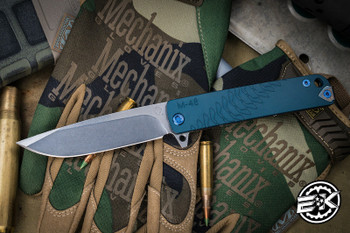9 Tips for Teaching Kids Knife Safety
Posted by Clayton on May 17th 2016
Children and knives don’t mix, and determining when to introduce knives to your children can be tricky business. Even so, every child should be educated on knife safety as early in life as possible. There’s a right way and a wrong way to go about this, which is why we’ve created this guide for teaching your children knife safety. Follow these tips, and your little tyke will be a whittler in no time.
- Determine if your child is old or mature enough to use a knife. There’s no secret formula for choosing the right age to start teaching your child knife safety. We think that, if your child is old enough to use their hands effectively and balance properly, it’s generally acceptable to start teaching them knife safety. Every child is different, so employ basic common sense based on your child’s level of maturity and motor skills.
- Start with a plastic knife. If your child is very young, their first knife should be a plastic one—something they can use to cut silly putty or similar materials. This can help teach them the hand-eye coordination they’ll need before moving up to the real deal. Plus, it’ll reduce the likelihood of a major accident.
- Work your way up to a small kitchen knife or a small fixed blade. We don’t recommend turning your child loose on a folding pocket knife until they have learned proper knife technique and hand movements. A folding knife can be too cumbersome for your child to use, and the locking mechanism can be dangerous for their small fingers. Their first real knife should be a small, fixed type of blade they can easily control.
- Always supervise your child while they are using the knife. This is especially important when they are first starting out. Always keep knives out of reach, and stress to your child that knives are extremely dangerous. Explain what could happen should they cut themselves or someone else. Feel free to lay it on a bit thick. Though children shouldn’t fear knives, they should know what they’re capable of. Let your child know knives should always be handled as tools and not toys. Never allow your child to engage in horseplay or roughhousing while holding or using a knife.
- Go slow and be patient. The initial knife safety lessons should be short and slow. For younger children, we recommend that knife use lasts from five to ten minutes at a time. You can gradually increase the amount of time your child uses their knife as they get older and continue to refine their skills. If their attention seems to be wandering, it’s probably a good time to put the knife down for the day and let them do something else.
- Talk your child through the entire process. You should always talk your child through what you’re using the knife for, whether you’re in the kitchen or in the woods. Let them know why they might need to use a knife. Communication is incredibly important when it comes to teaching anything. You should also teach them the vocabulary associated with your activity. Are you chopping, dicing, or peeling vegetables in the kitchen? Are you whittling or sharpening sticks in the woods? Explain these terms so your child can gain a greater understanding of what they’re doing. Not only is this a great bonding experience, but it’s also an excellent way of teaching them the real-life skills they’ll need later in life.
- Teach by example. Don’t try to pull any expert moves in front of your child. Even though your lightning-fast chopping skills may be impressive, your child learns by watching and imitating you. When you’re showing them how to use a knife, you should go as slowly and carefully as you’d like them to go when using a knife.
- Practice makes perfect. If you can, invite your child into the kitchen while you’re making dinner or preparing food. You can let them help you chop vegetables or cut bread. Give them as many opportunities to practice as you can. Over time, they’ll refine their hand movements.
- Always use common sense. Always teach your child basic safety rules for both indoor and outdoor use. Keep a first aid kit handy just in case an accident does occur. You know your child better than anyone, and personalizing your child’s knife safety experience is the key to ensuring they learn vital skills for using knives safely.
Teaching children knife safety isn’t easy, but, with a little patience and effort, you can teach your child knife safety and avoid potentially dangerous accidents.

